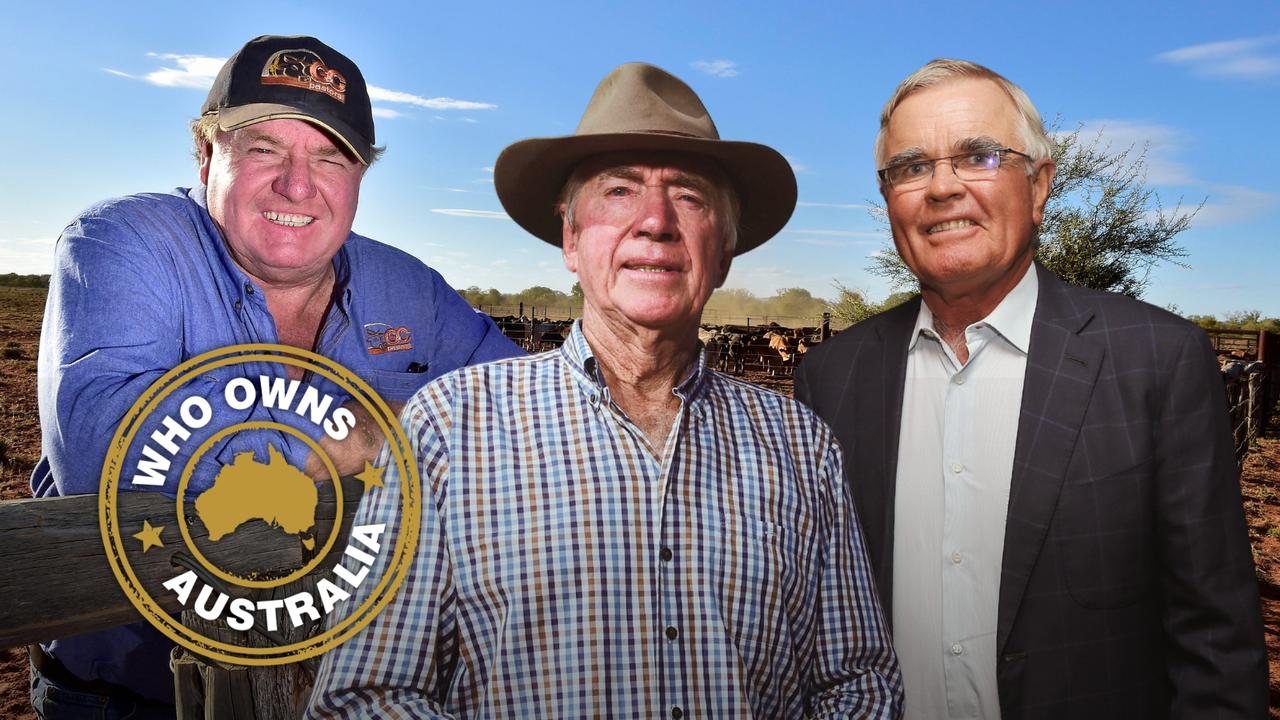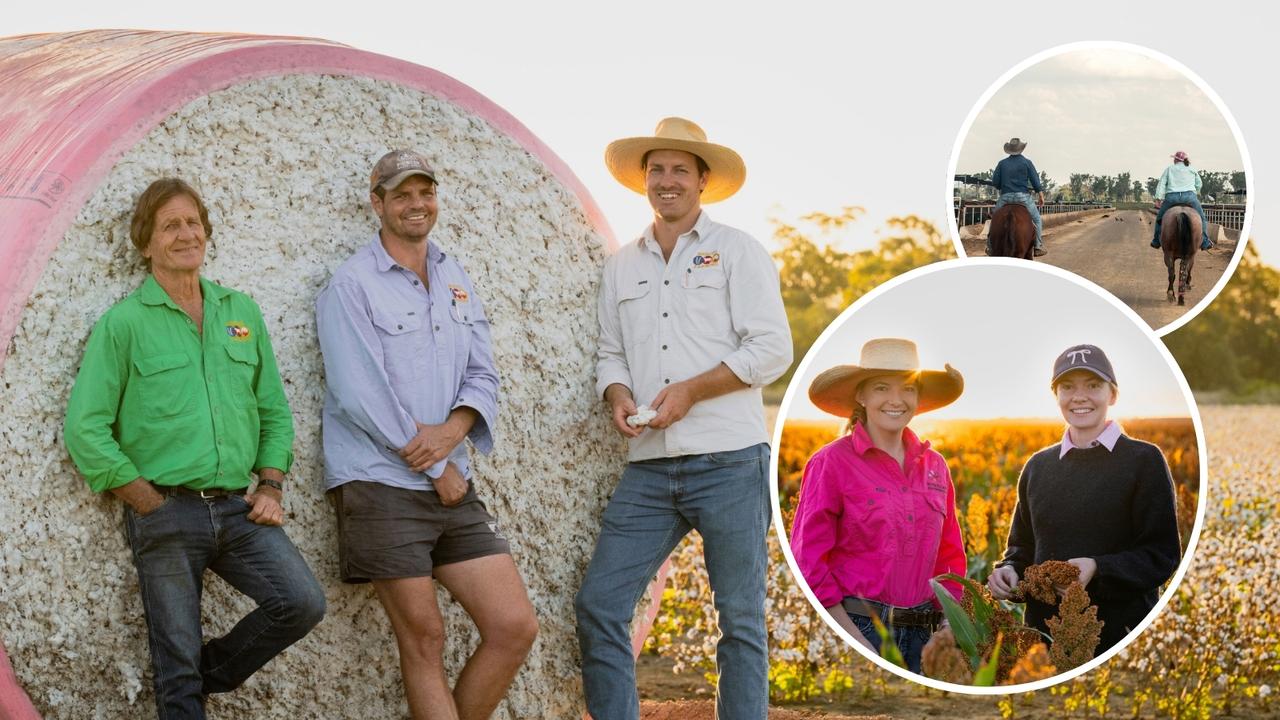Aquna Murray Cod Australia taking an apex predator from pond to plate
An ASX-listed aquaculture powerhouse at Griffith has raised $80m, with grand plans to produce 10,000 tonnes of fish a year.
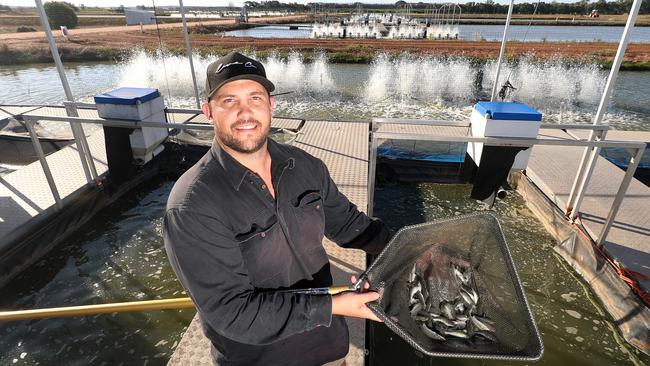
Surrounded by lush rice paddies, orchards bursting with citrus fruit and nuts, vineyards stretching across the horizon and hectares of dryland and irrigated cropping is a freshwater aquaculture company making a global splash.
Murray Cod Australia, an ASX-listed venture based at Griffith in the food bowl of NSW’s Murrumbidgee Irrigation Area, has hooked a growing number of world-renowned chefs, including the revered Heston Blumenthal, as well as North American, European, South East Asian and domestic diners on the apex predator of the Murray-Darling Basin river systems.
It’s easy to see why the Murray cod has served as a trophy fish to anglers for more than a century.
Its speckled skin is mesmerising to the eye. When hauled from the murky Riverina ponds they call home, the iconic native species glistens as if it has been coated in lacquer. A baking summer sun only adds to its lustre.
The big fish has an awesome power, and meaty weight. But underneath, its belly is almost delicate to the touch, hinting at the silky flesh that has captured the imagination of cooks and connoisseurs the world over.
“The flesh is what made me fall in love with the business,” says Murray Cod Australia chief executive Ross Anderson, gazing out over the company’s newest property, a 200-hectare holding at Stanbridge, about 40km south of Griffith.
“I tried it once at a local restaurant and from there I just wanted to be more involved.”
In less than a decade, Murray Cod Australia, via its Aquna brand, has developed its own unique, vertically integrated farming and processing system, swiftly becoming the world’s largest Murray cod producer taking more than 430 tonnes of fish from pond to plate in the past year.
“Our goal from day one was to go to 10,000 tonnes,” Anderson says. “Seafood is the most widely consumed and traded protein in the world, more than pork or chicken.
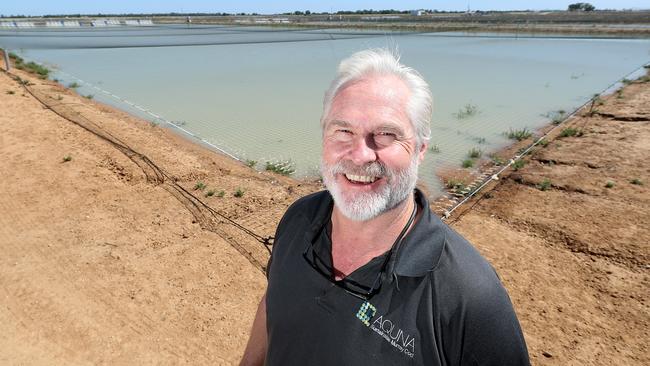
“Land-based aquaculture has been proven to be the most efficient way of doing it for thousands of years now. And the fact we are producing a really high quality product with its own unique Australian characteristics with a unique brand is special.
“The cod has a creamy white flesh with a very smooth texture and strong fat content. It is the rarest fine-dining fish in the world and that puts us in a great position to grow.”
SMALL FRY TO BIG FISH
A chartered accountant for the majority of his career, Anderson says he was chasing a new opportunity to expand beyond his previous agribusiness work about a decade ago when a 40-hectare farm at Bilbul, on the outskirts of Griffith, piqued his interested.
Located about 180km north of Wagga Wagga, and 575km inland from Sydney, the paddock in question belonged to farmer, agronomist and current Murray Cod Australia director Mathew Ryan. Tired of being a price taker with dryland commodity-based markets, Ryan wanted to create a niche product where he could build scale and control price at the same time.
Starting with a pair of 12-megalitre ponds, Ryan began growing Murray cod on a small scale, supplying a handful of local restaurants.
Soon after, one of the Riverina’s most successful innovators, George “Roger” Commins also jumped on board, becoming a non-executive director of the fledgling company.
By January 2017, Murray Cod Australia had raised $10 million from investors and was then reverse-listed on the ASX after taking control of former small gold explorer Timpetra Resources.
Prior to its listing, however, the wheels of innovation were already turning with Commins’ stainless-steel manufacturing company at Whitton playing a major role in constructing the unique customised equipment needed to breed, grow and produce Murray cod en masse.
The company’s launch-pad site at Bilbul is now vastly different to what it once was, despite looking much the same with an expansive shed and the ponds that started the company.
Now the shed is home to their juvenile weaning facility, taking millions of hatchlings from their Euberta and Grong Grong sites and giving them a temperature-controlled, quarantined environment to begin to grow and transition on to their pellet feed.
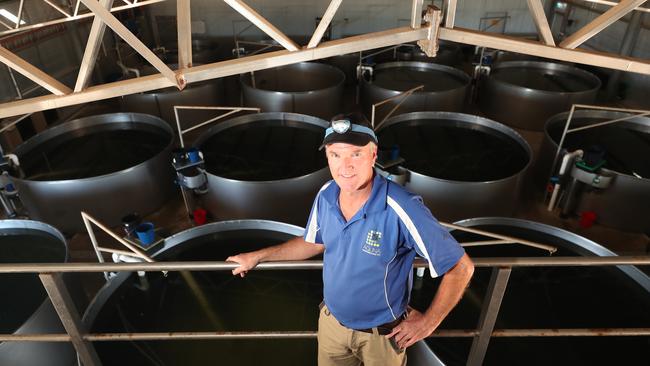
Rod Remke runs Aquna’s weaning operations, managing 34 reticulated aquaculture system tanks, which are home to about a million fingerlings weighing from 0.2 grams to more than four grams.
“We get the fingerlings from the hatchery and wean them here until they are big enough to transition to the juvenile ponds,” Remke says, brimming with passion. “It’s like they are on holiday in here; the temperature is controlled and there are no environmental influences.
“The fingerlings are fed three times per day, health checks are once a week and there are regular weight checks so you can see how fast they are growing.”
The Aquna cod are initially weaned on to a fish pellet mix, which is ground into fine pieces for the smallest juveniles, until they are big enough to feed on the larger pellets.
Fish pellets, different between brands, often contain a mix of aquatic proteins such as herring, krill, shrimp, bloodworm and well as pea protein, kelp and spirulina.
While an equal amount of pellets are dropped into the tanks, not all fish grow at the same rate, with the more aggressive and dominant juveniles in the tanks snapping up more than their fair share.
“They are like humans, you get tall, small, thin and fat,” Remke says. “We feed by a model and response, we can see their responses, behaviour and the waste.
“If I underfeed them they will get aggressive and bite each other, but if I overfeed I can see it coming back through the pipe when I feed them.
“They are also carnivorous, so you need to get them all the same size so they don’t eat each other. That’s when we grade them using a device to move the similar-sized fish through the tanks together, otherwise the larger fish in the tanks will continue to eat more and grow faster than some others.”
From Remke’s tanks, the fingerlings move to the company’s juvenile ponds at Bilbul and on McFarlanes, a block near Griffith where more ponds were constructed about five years ago in lease arrangements with local farmers.
Almost 500,000 smaller juveniles in total can be kept in the eight 5m-deep nets combined, where they are fed multiple times a day and graded often through a customised machine that looks like an oddity from a Doctor Who episode.

Constructed on a trailer, the device pumps the juvenile fish out of their cages, feeding them up into an automatic grading system, before three separate pipes push the graded fish back into their new cages, based on their size.
And on it goes until the fish from McFarlanes are ready to move to grow-out ponds, about 35km south of Griffith at Whitton, where they ultimately will be harvested, following a two-plus year growth cycle for a 2.5kg-plus sized Murray cod.
Whitton site manager David Baxter says controlling the Murray cod’s health and behaviour is his main priority prior to harvest.
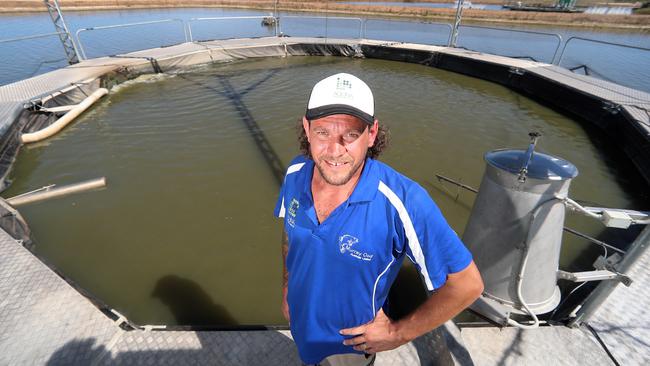
“For us and my team, it is all about feed. Through their feed we can keep the fish happy and healthy. You have to treat each pond like its own ecosystem,” he says.
“Overfeeding will reduce the quality of the water because of excessive waste, while if we underfeed they will be aggressive and lean, but we want a nice fat fish.
“And a happy and healthy fish is going to give us a better product in the end. That is what we want, we are aiming for a quality product because it is a fine-dining fish.”
FREE-RANGE INNOVATION
A fortunate set of unintended circumstances prompted the company to adopt a “free-range” model to grow their fish to harvest at their Whitton and under-construction Stanbridge properties.
“We discovered the free-range method by accident really,” Anderson says. “From the nets, when the fish are smaller, you have some escapees. Years later, we were short on supply due to reducing our stockings when the Covid pandemic really affected exports.
“We started searching the ponds for fish and we caught some bigger than 4-5kg, which have lived and grown in the dam on their own. Initially when we were discussing the developments of Aquna with NSW Fisheries, the nets were designed to keep the fish off the bottom of the ponds to ensure their eating quality.
“But what we have seen is that these escapees are just as happy, healthy and of the same, if not higher eating quality, than those in the cages.
“They have also grown faster and have had better health outcomes.
“So we are moving to this free-range grow-out model, including at our Stanbridge site, which is going to be a game changer.”
Across all its grow-out ponds and nurseries Murray Cod Australia holds about 600 megalitres of water, predominantly sourced from the Murrumbidgee Irrigation system, including licences for high security and general water.
At its current scale the company estimates it produces a gross return of $50,000 per megalitre of water used.
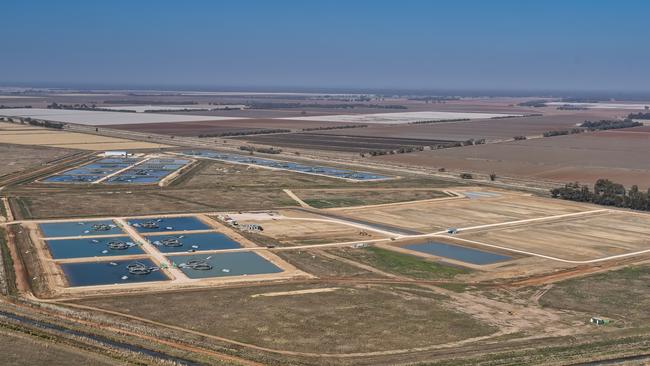
Earlier this year Aquna announced its new Australian Sustainable Protein Fund had bought its seed asset, the 200-hectare Stanbridge property, 10km east of Whitton, where it has since advanced construction of 30 ponds, with plans for a further 48 to be built.
Comprising predominantly clay-based soils, the property is ideal for holding water in the ponds.
It is estimated 700 megalitres will be needed to fill the Stanbridge development.
“We have the runs on the board in the sense that we have developed the market and a very good production system,” Anderson says.
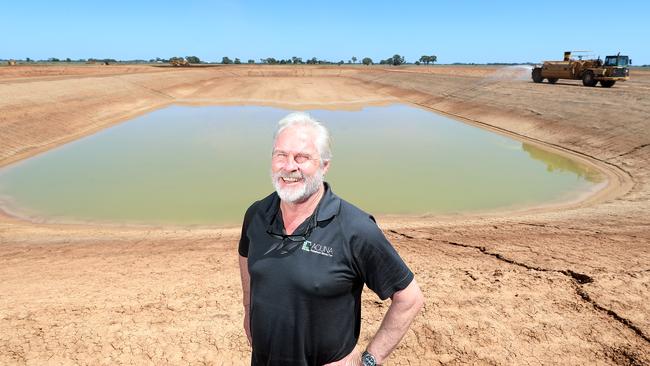
“We have raised $80 million in seven years, taking Aquna from a start-up and now it is in its adolescence.
“It takes a long time to build the IP (intellectual property), staffing, infrastructure and evolving the hatchling, breeding, feeding and grading processes.
“We have all that knowledge now and we have got it working well, now it is time to scale up.”
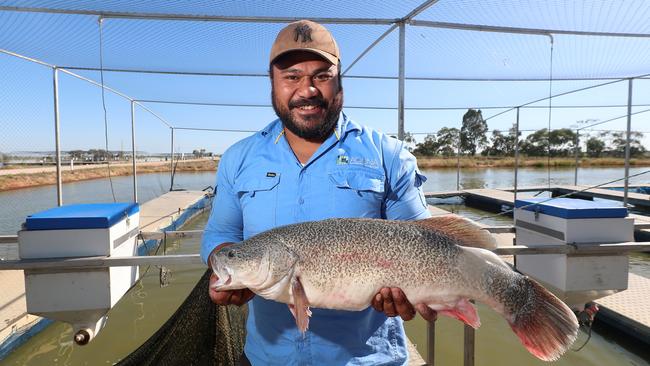
The Australian Sustainable Protein Fund is in its infancy, but aims to raise $100 million initially and grow to $400-$500 million by 2030 including a $20-$30 million farmland and $150-$200 million water portfolios.
Currently, Aquna’s grow-out ponds are harvested weekly via a sump with the returns delivered to their Griffith processing centre – a retrofitted former orange juice packing shed just kilometres from the town’s CBD.
Filled with state-of-the-art processing machinery, customised to the unique body shape of the Murray cod, harvests are processed throughout the week to order, packaged and then shipped to 130 Woolworths stores in Victoria and NSW, 39 Coles stores in Victoria, a range of Victorian fishmongers including at the Queen Victoria and South Melbourne markets, as well as 30 different retailers in NSW. Overseas buyers from the likes of Hong Kong, Vietnam and Singapore also place frequent orders.
Murray cod fillets retail for about $80 a kilogram, while Aquna’s premium caviar product is $72.95 for a 50g jar. A 2.5kg whole fish wholesales for $29.50 a kilogram.
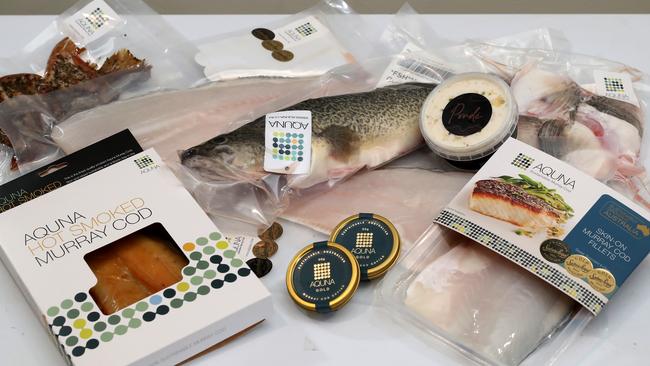
Last financial year Murray Cod Australia lifted its revenue by about 27 per cent to $25.11 million.
The company recorded a loss of $7.3 million last financial year, largely due to an 18 per cent drop in fish tonnes harvested, following decisions to reduce stocking levels during the pandemic summers of 2019-20 and 2020-21.
Murray Cod Australia is forecasting a marked increase in saleable Aquna fish during 2024-25 and 2025-26 after a 250 per cent increase in spawnings last year. Further growth is also earmarked for a 200-hectare site at nearby Gogeldrie, where the company is developing a new hatchery. They have also partnered with the CSIRO to pursue genetically modified Aquna Murray cod, designed for optimum growth and eating quality outcomes.
A partnership with NSW Fisheries has also produced 800,000 Murray cod fingerlings and 300 fish weighing 300-500g for stocking in the natural environment.
Staffing and expanding its growth, harvest and processing logistics will remain Aquna’s biggest challenges, but Anderson has his sights firmly set on meeting global demand for Murray cod, with an expectation staff will need to double to 200 by the end of the decade.
“In global terms, our goal of 10,000 tonnes is only a small amount of fish compared to the 120 million tonnes of fish produced across the world,” Anderson says.
“Sixty million tonnes of that is farmed and about 85 per cent of that is through freshwater aquaculture.
“But our fish is extremely rare. I mean it is only native to this part of Australia and it is so sought after by chefs. There is far more demand than we can supply and the market is growing.
“We want to ensure this is an absolute premium product, while expanding its global export, and giving all Australians the chance to taste this amazing native fish.”
MURRAY COD INDUSTRY IN AUSTRALIA
The size and value of Australia’s Murray cod industry could increase 10-fold in the next three decades, with industry leaders targeting $100 million of production by 2050.
AgriFutures Australia released the Australian Murray Cod Strategic RD&E Plan last year, estimating Australia’s premium white fish market produces 200,000 tonnes a year, as part of the nation’s $3.63 billion gross value product fisheries and aquaculture industry.
Aquaculture Association of Queensland president Bruce Sambell said the production of Murray cod was a sleeping giant for the market.
“Murray cod grows quickly, which makes it economical to produce, it’s good to eat and it’s an iconic species so it should be well received by consumers,” he says. “We envisage Murray cod could one day be like barramundi and sold on supermarket shelves.”
Sambell also says the species is positioned strongly to compete in premium white fish markets.
“Aquaculture producers in Australia are held to some of the strictest biosecurity regulations in the world. This puts our products in a much better position globally as it means we are less susceptible to foreign diseases,” Sambell says.
In 2019-20, production of Murray cod was estimated at 516 tonnes, with an estimated industry value of $9.2 million a year.
By 2021, there were only two operations producing more than 50 tonnes of Murray cod a year, one of which was Murray Cod Australia.




